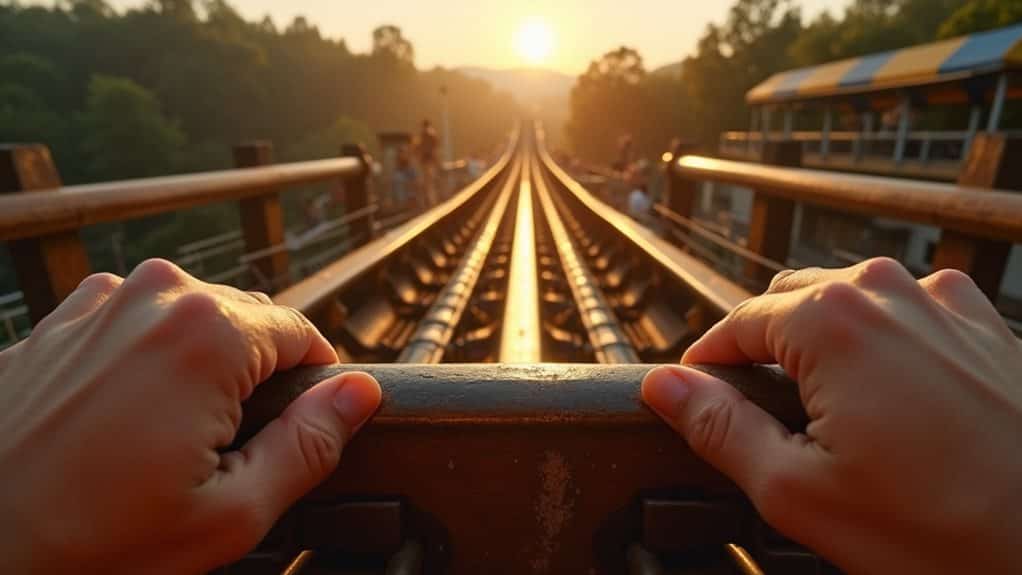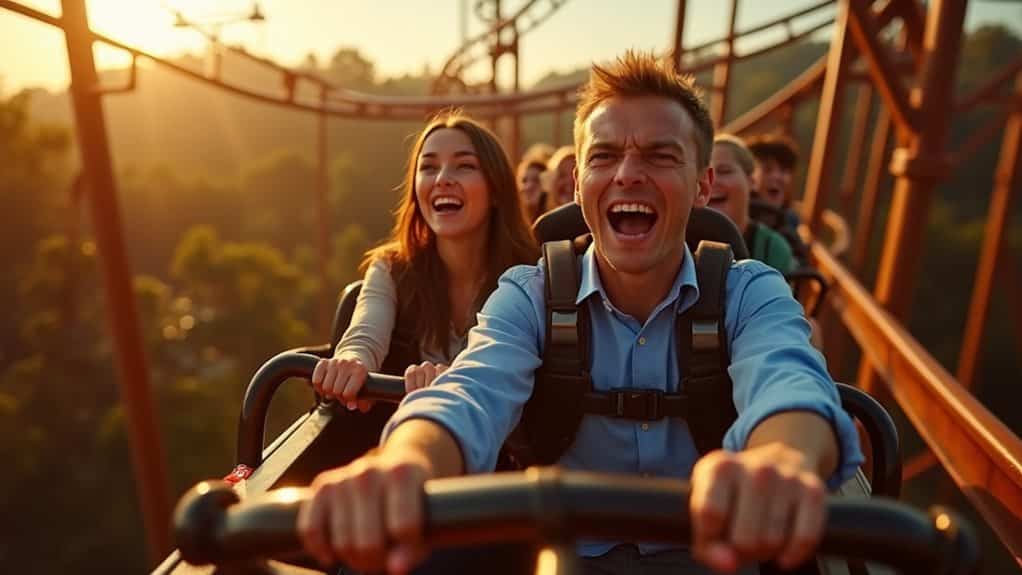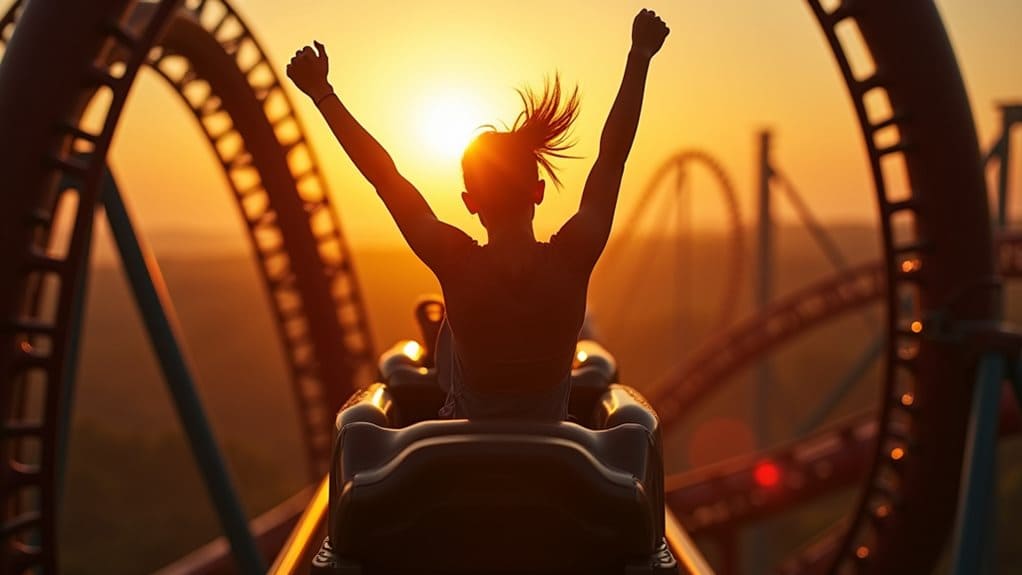Dreams about roller coasters often mirror your waking life’s emotional turbulence, symbolizing anticipation, loss of control, and the mixed sensations of fear and excitement. Just as your heart rate spikes to 158 bpm on a real lift hill, dream coasters reflect periods when you’re bracing for uncertain outcomes or steering through rapid changes. The same dopamine pathways that drive thrill-seeking in amusement parks also shape how your brain processes risk and reward during sleep, encoding memories of climbs and drops that parallel your psychological state and readiness to confront challenges ahead.
The Science Behind Your Racing Heart on the Lift Hill

Climbing that first hill triggers a cascade of physiological changes that convert your body into a state of heightened alert.
Your heart rate surges to an average of 158 bpm as anticipation activates your fight-or-flight response, flooding your system with adrenaline and cortisol.
Research confirms that arousal peaks during this ascent, not during the actual descent, making the lift hill the ride’s most anxiety-inducing phase.
This temporary spike in heart rate and blood pressure is generally benign for healthy young people, though those with underlying cardiac conditions may face increased risk.
People who faint from sudden drops in blood pressure may experience similar pre-fainting symptoms such as dizziness and blurred vision vasovagal syncope.
Dopamine and the Biology of Thrill-Seeking
Your appetite for roller coasters might be written in your DNA, as genetic variations in dopamine receptor genes—particularly DRD4 and DRD2—influence how intensely you experience reward and novelty.
These genetic differences affect dopamine signaling in your brain’s reward pathways, especially in regions like the nucleus accumbens and ventral tegmental area, which determine whether you’re the first in line for extreme rides or prefer watching from the ground.
The same neurobiological systems that evolved to reinforce survival behaviors now drive your craving for that next adrenaline-pumping drop, creating individual differences in how much excitement you need to feel satisfied. When you experience thrilling activities, bursts of dopamine release strengthen the neural connections in your reward system, making you more likely to seek out that experience again. Understanding how these reward pathways relate to thrill-seeking behavior can also shed light on why some people are drawn to emotional highs and lows in other areas of life.
Genetic Variations in Thrill-Seeking
When scientists first examined why some people rush toward roller coasters while others avoid them entirely, they found that genetics plays a surprisingly substantial role in thrill-seeking behavior.
Studies reveal that about 50% of sensation-seeking traits stem from genetic factors, particularly variations in dopamine receptor genes like DRD4. The 7-repeat allele variant correlates strongly with risk-taking behaviors, as people with fewer dopamine receptors require higher stimulation levels to achieve similar arousal.
Reward Pathways and Excitement
At the heart of every roller coaster experience lies dopamine, a neurotransmitter that converts ordinary moments into sources of intense pleasure and motivation.
When you anticipate that first drop, dopamine floods your brain’s reward circuits, changing potential danger into thrilling excitement. This chemical initially responds to rewards themselves but gradually shifts to cues predicting them, making the climb before the plunge equally exhilarating.
When Fear Meets Excitement: The Emotional Rollercoaster Within

As you climb that first hill, your heart rate spikes well before any physical forces act on your body, revealing that emotional anticipation alone can trigger intense physiological arousal.
This unique intersection of fear and excitement activates your fight-or-flight response while simultaneously releasing dopamine, the neurotransmitter that drives sensation-seekers to crave these unpredictable experiences.
The result is a paradoxical state where your brain processes threat signals and reward signals at the same time, creating the distinctive rush that defines the roller coaster experience.
Sleep quality and REM sleep duration also influence how vividly you remember these emotional experiences in dreams, with REM sleep playing a key role in processing emotions.
Anticipation Triggers Peak Arousal
The moment you’re strapped into your seat and the coaster begins its slow climb, your brain shifts into high gear. Your prefrontal cortex activates mental simulation, imagining what’s ahead, while your hypothalamus triggers autonomic responses like accelerated heart rate.
This anticipatory arousal combines cognitive expectation with physiological readiness, creating peak emotional intensity before you even reach the drop.
Dopamine Fuels Thrill Response
Pleasure itself becomes the engine that drives your body toward risk when dopamine floods your brain’s reward circuits.
This neurochemical surge intensifies with novelty and surprise, making each unexpected drop more rewarding than the last.
Your striatum activates when encountering new thrills, encoding prediction errors that reinforce sensation-seeking behavior.
Genetic variations in dopamine receptors explain why you might crave increasingly intense experiences to maintain that euphoric rush.
Who Loves the Ride? Personality Traits That Predict Your Preference
Screaming down a 200-foot drop at 70 miles per hour delights some people while terrifying others, and this split in preferences isn’t random.
Your personality traits largely determine whether you’ll love or loathe roller coasters. High scores in thrill-seeking, experience-seeking, and disinhibition predict enjoyment, while boredom tolerance helps you endure long lines.
Extroverts typically crave intense sensations, and your perception of risk modifies how thrilling you find each ride. Dreams of fatigue often signify communication difficulties and mental strain, suggesting riders who feel emotionally exhausted may be less inclined to seek high-intensity experiences and might prefer gentler attractions with more opportunities for mental rest.
Physical Safety and Health Considerations for Riders

Despite their reputation for thrills and excitement, roller coasters carry remarkably low statistical risks when you examine the actual numbers. You face approximately 1.3 injuries per million riders, with fatality odds around 1 in 170 million.
However, the high G-forces and rapid movements can cause head, neck, and back injuries, particularly whiplash and soft tissue damage, making proper restraints essential.
Measuring the Rush: How Researchers Study Roller Coaster Responses
Scientists strap on wearable sensors and venture into theme parks to capture what your body experiences during those stomach-dropping moments. Devices like Empatica E4 wristbands record your skin conductance, heart rate, and temperature at four samples per second throughout the ride.
Accelerometers track g-forces while post-ride questionnaires validate the physiological data against your subjective feelings, creating a complete emotional profile.
The Social Experience of Shared Thrills and Adrenaline

While sensors and wristbands capture the individual’s physiological response, roller coasters rarely operate as solo experiences. You’re screaming alongside friends, and that collective adrenaline spike creates social synchronization.
Your group’s emotional states converge through vocalizations and nonverbal cues, amplifying enjoyment. Shared anticipation in queues strengthens bonds, while simultaneous heart rate increases indicate physiological synchrony. Social setting directly modulates how you interpret fear and excitement.
Wrapping Up
Your response to roller coasters stems from a complex interplay of biology, psychology, and personality traits. Whether you’re drawn to the adrenaline rush or prefer keeping your feet on solid ground, you’re experiencing predictable physiological reactions shaped by dopamine, fear responses, and individual differences. Understanding these mechanisms won’t necessarily change your preferences, but it’ll help you recognize why you react the way you do when confronting these towering steel structures.

